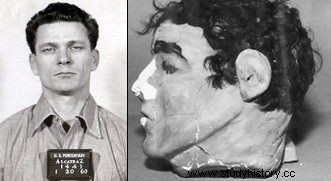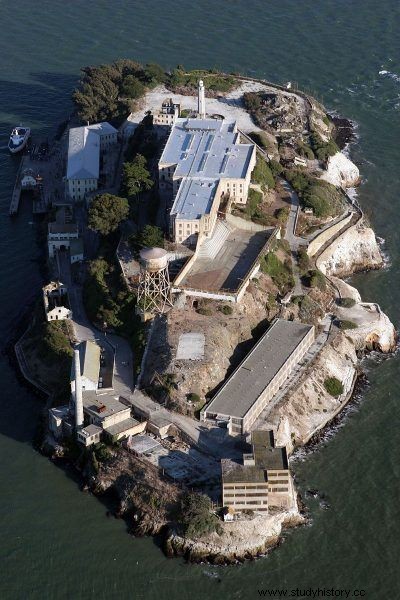Alcatraz. A maximum security prison located on a rocky island off the coast of San Francisco. Today it does not fulfill its main task, it is only a well-known and frequently visited tourist attraction. What is the history of this place and what was the famous escape from the island like?
Gannet Island
"La Isla de los Alcatraces" - these were the words of the Spanish traveler Juan Manuel de Ayala, as soon as he noticed a small rocky island on the horizon. The Spaniard didn't bother to come up with a name; observed that gannets (seabirds) were found in great numbers on the rocks and they became the "owners" of the island.
The island had a military purpose since the mid-nineteenth century. The prevailing "gold rush" and the discovery of deposits in the Sierra Nevada mountains attracted a large number of prospectors of this shiny ore to these regions. To maintain order in San Francisco (which was experiencing a financial boom) p resident Millard Fillmore proposed to build a military base in the area equipped with over a thousand cannons . It fell on the island of Alcatraz (which from 1859 was called Fort Alcatraz).

Alcatraz in the 19th century
In the 1880s, military buildings were turned into a military prison (used mainly during World War I), and in 1933 the island was taken over by the Federal Correctional Administration.
Inmates
On August 11, 1934, the first transport of prisoners arrived on the island. There were 137 dangerous people; murderers, dangerous thieves etc. Other prisons were getting rid of them, where the wayward inhabitants were not dealt with. There were over 50 FBI agents and 150 guards on Alcatraz, and the first director, James A. Johnston.
On the island, apart from the buildings intended for prisoners, there were also buildings for the families of workers. The children played within the prison walls, having the same childhood as their peers on land ; however, children were not allowed to play with toys that imitate weapons.
A ferry left the island several times a day (the break lasted from 2 to 5 am). Employees' families could easily get to San Francisco, for example, to do shopping (sometimes in the company of a prisoner being transported).
There was a kindergarten near the prison walls, as well as a club where employees and their families could have fun on weekends. There was also no problem with inviting guests, although they could not come to the island with weapons and ammunition.

Famous Alcatraz Prisoners
During the first years of Alcatraz's existence, there was a "rule of silence", which was the observance of silence by prisoners in addition to breaks at work and in the yard (which was used on weekends) . What happened to those who did not follow the rules?
Prison
Alcatraz was surrounded by the sea and strong sea currents, so the prisoners wash themselves in hot water so as not to get used to the cold water ; the kind that would await them in their escape. 90 guards worked here (shifts lasted eight hours), and their main task was to count prisoners 12 times a day.
The routine of everyday life was the same for every prisoner. Obedience was required. In order not to lead to a rebellion, it was assumed that the prisoner should feel good, i.e. get a tasty meal and not often see guards with weapons. Such a "appeased" criminal will be less prone to starting any problems. It is worth noting that the guards were not trained to rehabilitate prisoners, but rather to maintain absolute order and peace.
A visit to solitary confinement awaited the recalcitrant prisoners. These were located in the basement near large tanks intended for collecting rainwater. Drenched with moisture, dark and small, they were not suitable for prisoners. Due to the fact that it was quite easy to drill a hole in the walls, the prisoners were tied with chains that restrained their movements . A person sentenced to this punishment was given a meal once every three days (usually only bread). After their release, prisoners said that they slept on concrete or rock, and that there were no mattresses or beds in isolation rooms.
During the serving of their sentence, the prisoners had mental breakdowns more than once. As part of the protest, the Achilles tendons were most often cut, or their fingers were cut off . There were also suicides. In order not to bring the body to the brink of nervous exhaustion, the prisoners tried to keep themselves occupied. A popular solution was to take care of various animals - lizards, rats or birds (which of course was forbidden). Others were engaged in driving moonshine, the so-called pruno made from fruit (although alcohol was sometimes made from gasoline and milk).
The famous getaway and Al Capone
The walls of Alcatraz hosted the worst criminals, but also the famous ones like Al Capone. This alcohol dealer during Prohibition was given prison number 85 and the main task - cleaning the prison toilets daily, which probably contributed to his depression and downfall.
Alcatraz was like hell, so it is not surprising that the prisoners made several attempts to escape. 14 attempts were officially recorded (34 prisoners). The most famous escape took place on June 11, 1962, organized by two brothers - John and Clarence Anglins - and Frank Morris (Allan West was also involved in the escape).

Frank Morris was one of the most famous Alcatraz prisoners
Morris noticed that there was some empty space behind the ventilation grate under the sink in his cell. P with the help of a teaspoon, he managed to widen the opening and find the former corridor used by the plumbers working on the island. To find out where this corridor reached, Morris needed partners. They found themselves very quickly, as they were adjacent to Frank in cells. To discuss the details of the plan, the prisoners talked to each other while working in the workshop and in the cafeteria.
With the help of cutlery taken from the canteen, the prisoners dug holes in the walls of the cells. A great breakthrough in the work carried out was the removal by Morris of the old engine belonging to the vacuum cleaner from the workshop. With its help, he managed to create a device resembling a drill.
People worked several hours a day, usually just before the curfew (9:00 p.m.). The guard was informed about the approaching guard, and the rubble was taken to the ventilation shaft leading to the roof (it was the chosen escape route, then to get off the roof and overcome the wall surrounding the prison). Interestingly, no ranger guessed the prisoners' intentions during the routine cell checks. The ventilation grille was replaced with a dummy made of… soap and paper. It's hard to believe, but such a solution allowed for further work on the escape for the next several months. The prisoners also managed to steal 20 raincoats, which eventually served as the material used to create the raft (The material was successfully joined with cement, and the oars were made of plywood taken from the workshop).
To gain time (the escape was planned for late night hours) Morris and the Anglin brothers prepared mannequins that were supposed to resemble sleeping escapees . They were made of toilet paper and soap and painted with paints. The mannequins even had hair taken stealthily from the prison barber!

Due to its location, Alcatraz seemed to be the perfect prison
On June 11, 1962, everyone was ready to flee. After the silence of the night was announced, the prisoners prepared mannequins and then made their way to the shaft, covering the hole with an imitation of a grating. Brothers Anglinowie and Morris, already on the roof, realized that West was not with them (the latter, unfortunately, got stuck in the glass because he packed his equipment badly, and when he finally reached the roof, his friends were gone).
The other three climbed the wall and swam as far away from the island as possible on a makeshift raft. Hearing about them was lost, at least officially. Their bodies could not be found in the bay. In 2013, California police received a letter signed by John Anglin that his brother and Morris had died several years earlier (the information was made public in 2018). The reader also learns that John has cancer and agrees to return to prison as soon as the authorities provide him with medical care. The police conducted appropriate examinations of the letter, which in turn were determined to be inconclusive. The case of the famous escape remains unclear.
Alcatraz prison officially closed in 1963 due to high maintenance costs and large design flaws allowing escape.
